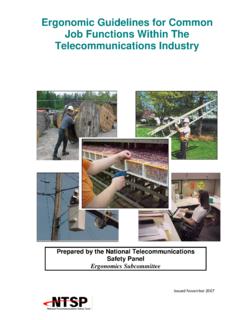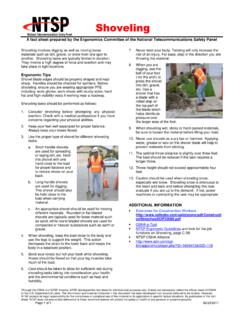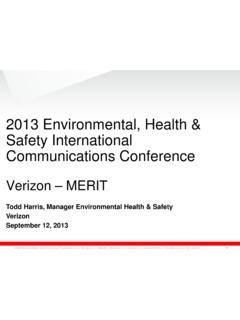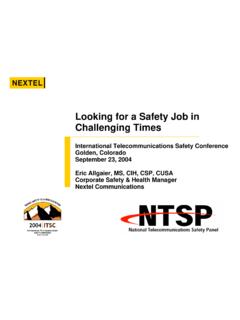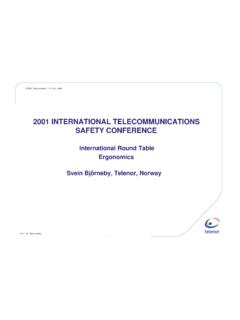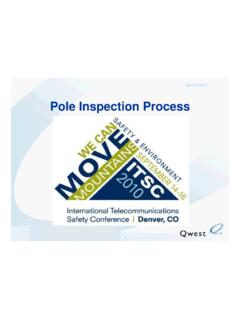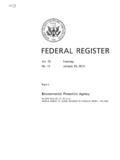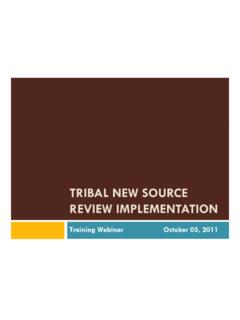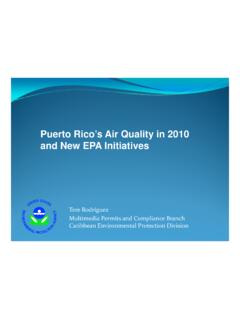Transcription of EPA REGULATORY UPDATE - EHSCP
1 EPA. REGULATORY . UPDATE . 2011 ENVIRONMENTAL, HEALTH & SAFETY. INTERNATIONAL COMMUNICATIONS CONFERENCE. SEPTEMBER 27, 2011. CHET M. THOMPSON. (202) 624-2655. Improving Regulation and REGULATORY Review President issued Executive Order 13563 on 1/21/11. Purpose: improve development of new regulations and review of old regulations General Principles: Propose regulation only when benefits justify costs Tailor rules to impose least burden on society Select options that maximize net benefits Specify performance objectives Identify and assess alternative to direct regulation Retroactive Review Agency solicited comments first half of 2011. EPA REGULATORY Review EPA Final Plan for Periodic Retrospective Reviews of Existing Regulations Published August 2011.
2 Adopted Four Initiatives: Electronic Reporting Improved Transparency: increased disclosure of compliance and efficacy Innovative Compliance Approaches: efficient/effective and least- burdensome Systems Approaches/Integrated Problem Solving: REGULATORY /non- REGULATORY approaches Selected 35 REGULATORY Reviews 16 early actions . 19 longer terms actions Will Undertake Reviews Every Five Years Early Actions . Gasoline and diesel regulations: reducing reporting and recordkeeping Equipment leak detection and repair: reducing burden REGULATORY certainty for farmers: working with the Department of Agriculture (USDA) and states Modern science and technology methods in the chemical regulation arena: reducing whole-animal testing, reducing costs and burdens, and improving efficiencies Electronic online reporting of health and safety data under the Toxic Substances Control Act (TSCA); Federal Insecticide, Fungicide, and Rodenticide Act (FIFRA).
3 And Federal Food, Drug and Cosmetic Act (FFDCA): reducing burden and improving efficiencies National Priorities List rules: improving transparency Quick changes to some TSCA reporting requirements: reducing burden National Pollutant Discharge Elimination System (NPDES): coordinating permit requirements and removing outdated requirements Early Actions . National primary drinking water regulations Long Term 2 Enhances Surface Water Treatment: evaluating approaches that may maintain, or provide greater, public health protection Combined Sewer Overflows (CSOs) and integrated planning for wet weather infrastructure investments: providing flexibilities Vehicle regulations: harmonizing requirements for: Greenhouse gas and fuel economy standards Vehicle emission standards Multiple air pollutants: coordinating emission reduction regulations and using innovative technologies NSPS reviews and revisions under CAA.
4 Setting priorities to ensure updates to outdated technologies CAA Title V Permit programs: simplifying and clarifying requirements Innovative technology: seeking to spur new markets and utilize technological innovations The costs of regulations: improving cost estimates Longer-Term Actions Vehicle fuel vapor recovery systems: eliminating redundancy New Source Performance Standards (NSPS) under the CAA for grain elevators, amendments: updating outmoded requirements and relieving burden Sanitary Sewer Overflow (SSO) and peak flow wet weather discharges: clarifying permitting requirements E-Manifest: reducing burden Electronic hazardous waste Site ID form: reducing burden Consumer confidence reports for primary drinking water regulations: providing for the open exchange of information Reporting requirements under Section 303(d) of the Clean Water Act (CWA): reducing burden Export notification for chemicals and pesticides: reducing burden and improving efficiencies Water quality trading: improving approaches Water quality standard regulations: simplifying and clarifying requirements Longer-Term Actions State Implementation Plan (SIP) process: reducing burden National primary drinking water regulations for lead and copper.
5 Simplifying and clarifying requirements Adjusting threshold planning quantities (TPQs) for solids in solution: reducing burden and relying on scientific objectivity Integrated pesticide registration reviews: reducing burden and improving efficiencies Certification of pesticide applicators: eliminating uncertainties and improving efficiencies Polychlorinated biphenyls (PCB) reforms: improving efficiencies and effectiveness Hazardous waste requirements for retail products: clarifying and making the program more effective Contaminants under the Safe Drinking Water Act (SDWA): coordinating REGULATORY requirements Section 610 reviews: coordinating requirements EPA Future REGULATORY Reviews Review overseen by REGULATORY Policy Officer, the Associate Administrator for the Office of Policy EPA intends to conduct reviews every five years and encourages public to identify possible areas for reform at any time EPA will start each review period by soliciting public input EPA to use Semiannual REGULATORY Agenda and website, to aid the public in tracking reviews EPA will make data and analyses available whenever possible Notice-and-comment opportunities when making modifications to regulations EPA REGULATORY Review EPA Process Going Forward Four Steps: 1.
6 Select Rule Nominations: from public and in-house EPA experts 2. Assess generally whether the executive order is likely to have a bearing on the regulation's review 3. Fully analyze each regulation and review the following areas: Benefits justify costs Least burden Net benefits Performance objectives Alternatives in direct regulation Quantified benefits and costs/qualitative values Open exchange of information Coordination, simplification, and harmonization across agencies Innovation Flexibility Scientific and technological objectivity 4. Make Necessary Modifications EHSCP Comments General Support for Retroactive Reviews Requested review of: Allow for electronic recordkeeping and centralized storage Harmonization of EPCRA Tier II reporting Single-point submission of EPCRA data RCRA Electronic Manifesting Selected Reviews of Potential Interest to EHSCP .
7 E-manifesting: reducing burden EPA wants to host nation-wide online manifest system Still would have option to use paper form Real-time tracking of waste shipments EPA made budget request in FY 2012 to develop system Contingent on congressional approval of EPA's authority to collect user fees NSPS Reviews and Revisions: Updating Technology EPA to set priorities for which NSPS to review Criteria for review: meaningful improvement in air quality/public health (based on improvements in technology). Timing: EPA to issue ANPR some time this Falloutlining approach Selected Reviews of Potential Interest to EHSCP . Water Quality Trading EPA will review the 2003 Water Quality Trading Policy and possibly increase market- based approaches to pollution reduction Considering storm water trading significant potential for trading allowances Workshop in 2012 to solicit ideas from the public, particularly ways to reduce barriers to trading Selected Reviews of Potential Interest to EHSCP .
8 PCB Reforms EPA will examine existing PCB guidance and regulations to harmonize REGULATORY requirements related to harmful PCB uses and PCB cleanup PCB cleanup program may create barriers to timely cleanup of sites contaminated with PCBS -- EPA trying to improve regulations for quicker and more effective clean up EPA will review no earlier than 2013. Other Upcoming EPA Rulemakings of Interest to EHSCP Members Industrial, Commercial, and Institutional Boilers EPA finalized rule in March 2011 and simultaneously granted reconsideration EPA stayed rule in May 2011. Reconsideration notice expected this Fall Final decision on reconsideration expected next Spring National Ambient Air Quality Standards 2013 Ozone Review Proposed rule by October 2013.
9 Final review by 2014. Implementation of 2008 standard ppm 52 areas with monitors above; many more areas contributing Finalize designations by mid-2012. States then get 3 years to develop SIPS. Other Upcoming EPA Rulemakings of Interest to EHSCP Members National Ambient Air Quality Standards : EPA promulgated final particulate matter ( PM ) NAAQS in October 2006. These standards maintained the 1997 primary and secondary annual standards at 15. micrograms/cubic meter ( ug/m3 ), but substantially increased the stringency of the PM daily standards. In the same rulemaking, EPA also maintained the coarse . PM10 daily standard at the level previously established (150.)
10 Ug/m3), but revoked the PM10 annual standard EPA initiated another five-year review of the PM NAAQS. almost immediately following finalization of the 2006. standards EPA expected to propose a revised NAAQS in 2012 and a final rule in 2013. Other Upcoming EPA Rulemakings of Interest to EHSCP Members SO2 and NO2 Secondary NAAQS. EPA is under consent decree to finalize new secondary standards for sulfur dioxide (SO2) and nitrogen dioxide (NO2) by March 2012. EPA had considered setting new secondary standards on the basis of: (1) direct effects on vegetation from exposure to gaseous SO2 and NO2; and (2) effects from the deposition of oxides of sulfur and nitrogen on sensitive ecosystems and waterbodies ( , acid rain, effects on nutrients in soils).
